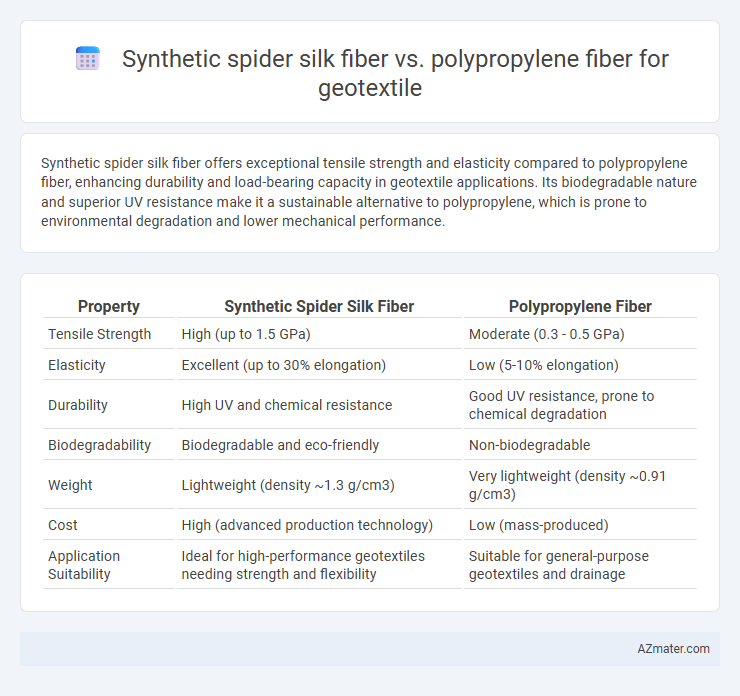Synthetic spider silk fiber offers exceptional tensile strength and elasticity compared to polypropylene fiber, enhancing durability and load-bearing capacity in geotextile applications. Its biodegradable nature and superior UV resistance make it a sustainable alternative to polypropylene, which is prone to environmental degradation and lower mechanical performance.
Table of Comparison
| Property | Synthetic Spider Silk Fiber | Polypropylene Fiber |
|---|---|---|
| Tensile Strength | High (up to 1.5 GPa) | Moderate (0.3 - 0.5 GPa) |
| Elasticity | Excellent (up to 30% elongation) | Low (5-10% elongation) |
| Durability | High UV and chemical resistance | Good UV resistance, prone to chemical degradation |
| Biodegradability | Biodegradable and eco-friendly | Non-biodegradable |
| Weight | Lightweight (density ~1.3 g/cm3) | Very lightweight (density ~0.91 g/cm3) |
| Cost | High (advanced production technology) | Low (mass-produced) |
| Application Suitability | Ideal for high-performance geotextiles needing strength and flexibility | Suitable for general-purpose geotextiles and drainage |
Introduction to Geotextile Fibers
Synthetic spider silk fiber offers exceptional tensile strength and elasticity, making it a highly durable option for geotextile applications, whereas polypropylene fiber provides cost-effective and chemical-resistant properties widely used in soil stabilization and erosion control. Geotextile fibers function by reinforcing soil, improving filtration, and controlling drainage in civil engineering projects. The distinctive biomechanical properties of synthetic spider silk fibers position them as innovative alternatives to traditional polypropylene fibers, enhancing the performance and lifespan of geotextile materials.
Overview of Synthetic Spider Silk Fiber
Synthetic spider silk fiber exhibits exceptional tensile strength, elasticity, and biodegradability compared to polypropylene fiber commonly used in geotextiles. Engineered from recombinant spider silk proteins, it offers superior environmental sustainability and resistance to UV degradation, enhancing soil stabilization and erosion control applications. The advanced molecular structure of synthetic spider silk fibers enables improved load distribution and long-term durability in geotechnical engineering projects.
Overview of Polypropylene Fiber
Polypropylene fiber is widely used in geotextile applications due to its high chemical resistance, low density, and excellent tensile strength, making it effective for soil stabilization and erosion control. Its hydrophobic nature ensures minimal water absorption, enhancing durability and longevity in harsh environmental conditions. Compared to synthetic spider silk fiber, polypropylene is more cost-effective and readily available, though it lacks the superior strength and elasticity of spider silk variants.
Mechanical Strength Comparison
Synthetic spider silk fiber exhibits superior tensile strength and elasticity compared to polypropylene fiber, making it more effective in withstanding heavy loads and dynamic stress in geotextile applications. The tensile strength of synthetic spider silk can reach up to 1.3 GPa, significantly higher than polypropylene fibers, which typically have a tensile strength around 0.6 GPa. Enhanced mechanical strength and flexibility of synthetic spider silk contribute to longer durability and improved soil stabilization in geotechnical engineering projects.
Durability and Longevity
Synthetic spider silk fiber exhibits superior durability and longevity compared to polypropylene fiber in geotextile applications due to its exceptional tensile strength, UV resistance, and biodegradability. While polypropylene fibers can degrade under prolonged UV exposure and harsh environmental conditions, spider silk fibers maintain structural integrity and resist microbial attack over extended periods. These qualities make synthetic spider silk an innovative and sustainable choice for long-lasting geotextile solutions in erosion control and soil stabilization.
Environmental Sustainability
Synthetic spider silk fiber exhibits superior environmental sustainability compared to polypropylene fiber in geotextile applications due to its biodegradability and reduced ecological footprint. Polypropylene fiber, derived from petroleum, contributes to microplastic pollution and persists in the environment for centuries, posing significant ecological risks. Utilizing synthetic spider silk fiber enables eco-friendly soil stabilization and erosion control with minimal long-term environmental impact.
Cost and Production Feasibility
Synthetic spider silk fiber offers superior tensile strength and biodegradability compared to polypropylene fiber, but it remains significantly more expensive due to complex biosynthesis and limited large-scale production capabilities. Polypropylene fiber is cost-effective and widely produced through established petrochemical processes, making it more feasible for large-scale geotextile applications despite its lower environmental compatibility and weaker mechanical properties. The high production costs and scalability challenges of synthetic spider silk currently restrict its commercial viability in the geotextile market compared to the economically efficient polypropylene alternatives.
Biodegradability and Eco-Impact
Synthetic spider silk fiber demonstrates superior biodegradability compared to polypropylene fiber, breaking down naturally without releasing harmful microplastics into the environment. This enhanced eco-impact significantly reduces soil and water pollution often associated with traditional polypropylene geotextiles. Its renewable, bio-based origin offers a sustainable alternative, contributing to reduced carbon footprint and improved ecosystem health in geotechnical applications.
Applications in Civil Engineering
Synthetic spider silk fiber in geotextile applications offers superior tensile strength, elasticity, and biodegradability compared to polypropylene fiber, enhancing soil stabilization and erosion control in civil engineering projects. Its exceptional durability and environmental compatibility make it ideal for reinforcement in road construction, retaining walls, and slope protection, outperforming traditional polypropylene fibers prone to UV degradation and chemical resistance issues. The lightweight, high-strength nature of synthetic spider silk fibers allows for innovative, sustainable solutions in infrastructure development with improved longevity and reduced environmental impact.
Future Perspectives and Innovations
Synthetic spider silk fiber offers superior tensile strength, elasticity, and biodegradability compared to polypropylene fiber, making it a promising material for future geotextile applications. Innovations in biotechnological production methods aim to scale synthetic spider silk fiber cost-effectively, enhancing its commercial viability and environmental sustainability. Research continues to focus on integrating synthetic spider silk fibers into composite geotextiles, improving soil stabilization and erosion control while reducing plastic waste impact.

Infographic: Synthetic spider silk fiber vs Polypropylene fiber for Geotextile
 azmater.com
azmater.com